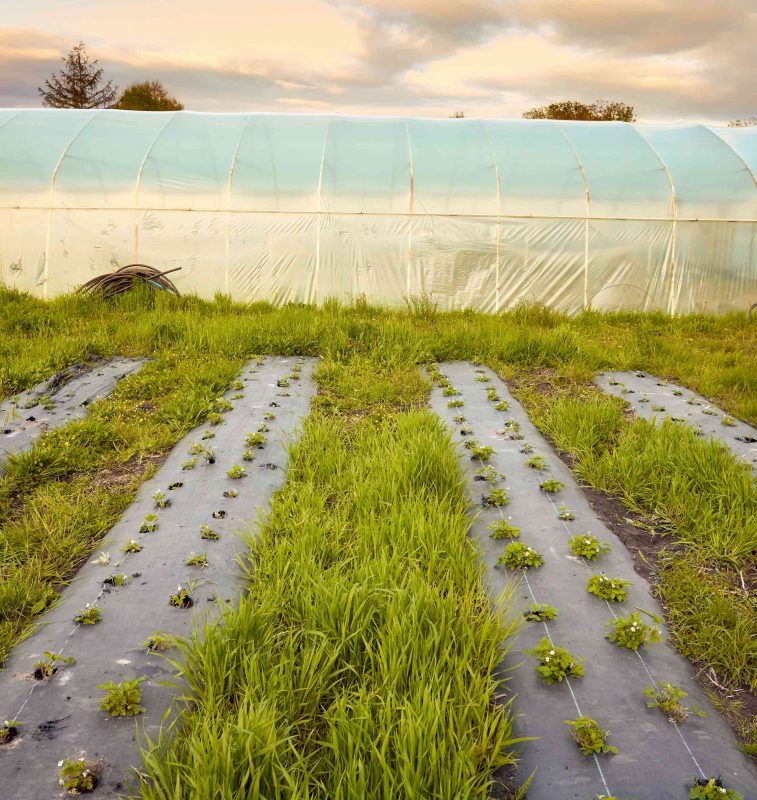Which types of mulches would be perfect for your garden? In gardening, mulching is known as the most effective time-saver with cost-friendly to enhance soil quality and plant growth. Many decades ago, seasoned gardeners always suggest using mulch as a lawn care tool which doesn’t require you much effort to water, weed, and fight pests. No matter whether you tend to have flower beds or garden beds, mulching material will also help the fruits, vegetables, and flowers be healthier, even when you’re just a beginner.
There are many types of mulch with different functions served in home garden use, from decorative purposes to insulating the soil, warding off pests, or fertilizing. Regardless of the diverse types of mulch, they all have the same goal: to keep the soil moisture and prevent weeds. Prices of mulch types range from free such as grass clippings to more expensive like rubber mulch with its own functions. You need to consider something efficient that perfectly fits your specific plants.
In this article, we’ll figure out deeply the difference between organic mulches and inorganic mulches which are the most common category of mulch types with their benefits, costs, and how to pick the perfect ones. The key to choosing the best mulch depends on what sort and where you’re going to mulch.
Keep reading our top 10 types of mulch that covered your needs along with some tips and tricks to best protect your plants.
Don’t hesitate to call us TODAY at (206) 265-2940
What Are Mulches? – Bothell Landscaping
Mulch is any material used to spread over the landscaping with the main aim to help the soil moisture, strengthen plant roots, and prevent erosion and weed growth. Besides the function of protecting plant roots and vegetable gardens, mulch can give your lawn loads of decorative appearance.
With a wide range of prices, any gardeners can find from free mulch material to an expensive one for your backyard. Let’s explore deeply and choose which type of mulch would be perfect for you.
Benefits of Mulch
No one will deny the huge advantages of mulch which doesn’t contain any disadvantages. This method has become a farming revolution through decades and created a basis for permaculture gardening. So why is it so good?
Discourage Weeds
Mulch is the easiest and safest to get rid of weed seeds. Although this method will not totally suppress weeds in your vegetable garden because of their tough root systems, mulching can reduce the number of weed seeds taking over your flower beds. Like other plants, most weed seeds need sunlight and water to germinate, so a mulch layer acting like a barrier will prevent weeds from reaching these vital elements during their growing process.
Explore more: How to Get Rid of Garden Weeds
Improve Soil Quality
Many gardeners realize that organic mulch can release moisture and nutrients underneath the ground which will allow some beneficial microorganisms to grow over time. As we all know, if the ground is not well covered, bare soil will lack moisture and face the rapid desertification process.
Retain Moisture
On top of them, mulch layers can reduce the evaporation of moisture and conserve water in the soil. This also means that you need to water less but still give enough water for plants. In some areas, water is so scarce that there will have no free charge for water to provide for gardens and farming. Mulch can be said not only to have ecological benefits but for financial points as well.
Protect Plants from Extreme Weather
Mulch protects soil structure in extreme weather areas, especially in the winter and summer. Acting like a temperature leveler, mulch helps insulate the soil, prevent heat loss and keep the soil warm in the winter which can create a cozy condition for a garden bed to best grow. In the summer, mulch helps the soil cool, and therefore protects roots from detrimental damage.
>>> Tips to Protect Garden Plants in Winter HERE
Decorative Function
Some types of mulches have a decorative look with a variety of colors. They can make your garden border cleaner with homogeneity when some colors of mulch materials totally match as a part of the flower bed composition.
Organic vs Inorganic Mulch
In general, both types of mulches also discourage weeds while organic mulch can additionally provide nutrients to improve the soil condition. We will deeply figure out what each specific type is.
Organic Mulch
Organic mulch is a material that will decompose over time and release nutrients into the soil after degrading so that the soil condition could improve to help the growth of plants. Organic mulches include plant-based materials such as chopped leaves, pine needles, wood chips, straw or hay, tree bark, and so on. Since they are all natural materials available in any home garden, even from leftover garden waste, these mulch types are the most environmentally friendly.
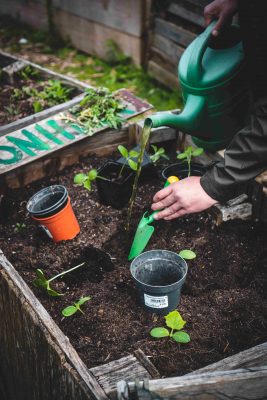
However, organic mulch will slowly decompose and disappear into the soil over time, and therefore you need to replenish it periodically to best stop weed growth and boost soil quality through beneficial microbes. Although these types of mulch are mostly free, if you purchase from your local garden center with a high amount for future storage, it can add up to your bill.
Inorganic Mulch
Inorganic mulches will not break down over time so you’ll not need to replace them as frequently as organic mulches. This also means that the inorganic mulch will not release nutrients and add them to improve soil conditions. This type of mulch is perfectly suitable for those who want long-lasting mulches, but it is their permanence that you’re hard to remove if you change your mind.
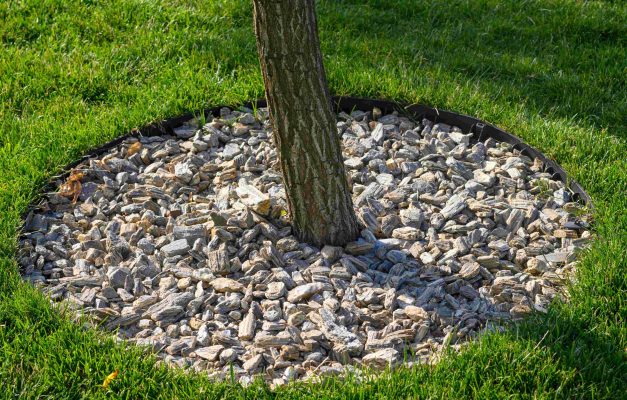
However, inorganic mulches can be more beneficial than organic mulches in some situations. If you are in favor of low-maintenance types of mulch, this inorganic one is good for you since you just need to replenish it yearly at most. Some inorganic mulches include gravel, river rocks, black plastic, and landscape fabrics.
Types of Mulches
1. Straw Mulch
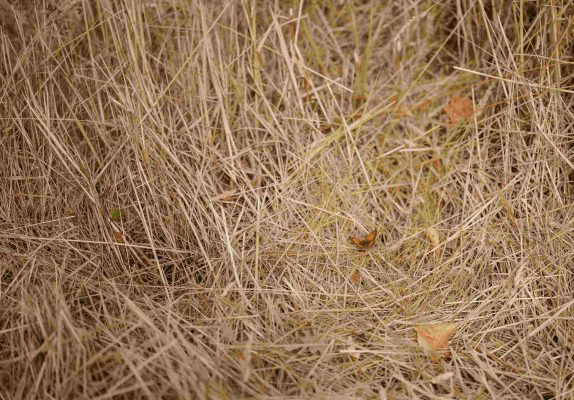
If you’re planting vegetable gardens or newly seeded lawns, straw mulch is an ideal option in providing spiders and beneficial insects the best place to control insects. This mulch is made from stalks of grain plants which look cleaner than hay mulch. While hay can bear some unwanted seeds along with its stalk, straw mulch is weed-and-hay free.
The decomposing process of this mulch happens easily after 6 – 10 weeks and adds more organic matter to the soil, as well as moisture retention, prevents weeds, and protects the plants from soil-borne diseases. Thanks to its reflecting soil surface, you can also grow some flora such as tomatoes, strawberries, peppers,… in straw since they can receive light from both suns and extra doses of reflected sunlight from mulch below.
Straw is also easily raked up when you notice the spread of fungi under wet gardens. Straw is very cheap and available at any garden store. But be careful to avoid purchasing hay mulch instead since they might look the same and hay will bring an influx of weeds into your garden plants.
2. Shredded Bark and Wood Chips
Wood chips or shredded bark are made of trunks and branches of trees which become very popular throughout the country.
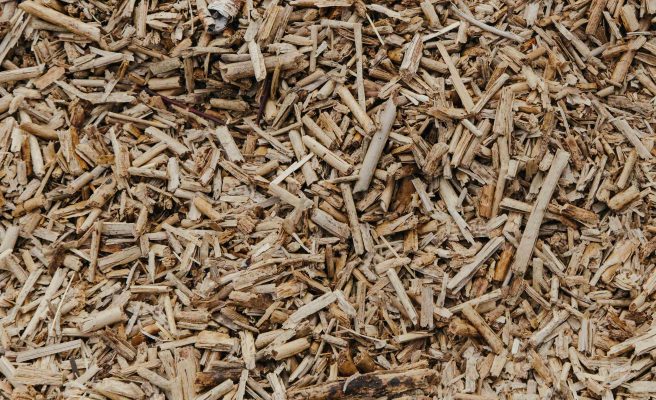
Since they are inexpensive, you can purchase loads of these decorative mulch bags from your local garden center. Wood chips are usually dried and treated before being packaged into selling bags for color longevity to best reduce weed growth, insulate the soil, and improve moisture retention. For cheaper options, let’s call some local tree-care companies to ask whether they have any bark wood chips on hand to save money.
Contact us for a free consultation for tree care
Wood chips can last longer than other popular choices such as straw, leaves, or newspaper mulch. However, the only disadvantage of this type of mulch is that they are easily washed away since fresh wood chippings absorb nitrogen from the soil. Be careful and use them on your walkways, garden pathways, or shrub borders than in vegetable gardens where there are no plants because the nitrogen absorbing process will damage the growing plants.
If you have many trees in your backyard, try shredding the fallen leaves or bark to create nutrient-rich mulches for free. And with the large size of softwood chippings and a natural look, they fit well for garden landscaping purposes. Depending on the type of wood, it might break down slowly (softwood chips) or quickly for soil improvement (hardwood chips).
There are some different types of wood chip mulch, including chestnut, oak, teak, poplar, fir, mahogany, and so on with a wide range of prices.
3. Grass Clippings

Another organic mulch is grass-clippings mulch with both advantages and disadvantages. With just a lawn cutter or lawnmower, you will have a steady supply of mulch from remaining grass clippings and reduce your garden waste at the same time.
Although they just last for a few weeks, this is a wonderful option if you’re looking for something short-term and eliminate weeds well, especially in vegetable gardens. But if you’ve already used herbicides or pesticides on your lawn garden, don’t add more grass cuttings since they totally suffocate your entire lawn.
This type of mulch provides excellent nitrogen for garden beds and allows the nutrients to blend into the soil. However, this mulch layer has a high content of water and tends to mat together which can become quite slimy, lack oxygen, and prevent moisture from getting through, therefore, just lay a thin layer on the garden. One more: grass clippings can have a foul odor during the decomposing process, so many experts recommend using them away from where you spend most of the time.
Tips: Do not use grass clippings from mature plants since they can sow seeds between your vegetable garden and start rotting.
>>> Read more: When to Water Grass Garden
4. Shredded Leaves
Why don’t you use something dumped over your lawn available every season? Leaf mulch is another popular type of mulch used in farming and gardening. You can have this free source of mulch material by collecting fallen leaves every autumn and shredding them. In fact, you can always produce this organic mulch yourself with no machine whenever the fall comes, and put the leaves somewhere dry, ready to use.
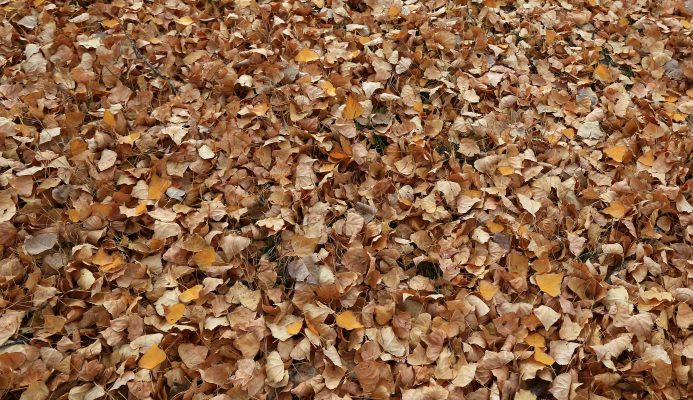
This is a high-nutrient mulch layer for soil regeneration and provides plant food with some beneficial soil-improving creatures underneath the ground. But leaf mulch is not always an attractive option for landscaping purposes. It might look a bit messy without being shredded and become compacted which will create an opportunity for mold growth.
You’ll need a thick layer of dry leaves to insulate the garden over wintertime but still provide enough oxygen to keep the soil not anaerobic. If this process happens, rake the leaves up and dig the rotting leaves out for a productive garden.
5. Pine Needles
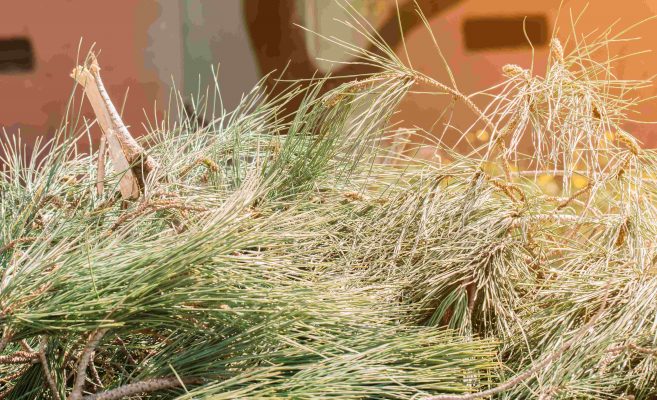
If you already have pine trees or conifers in your garden, this mulch type could become a completely-free mulch with natural-looking for decoration which will protect your soil from erosion. If not, purchase from landscaping or gardening companies with some discounts. However, pine mulch cannot be used generically, especially when you use mulch as a weed tool.
Pine mulch can acidify the soil while most plant trees prefer neutral to alkaline soil. Unless you have the right trees in the vegetable garden, forget using pine needles. This mulch is a great choice for insulating the ground and keeping warm soil, but nothing to do with perfect weeders.
This mulch decomposes very slowly that can last a year without replenishing. Although they start breaking down after a few weeks once established, this process needs from 3 – 4 years to completely decompose.
See our tree-care gallery
6. Landscape Fabric
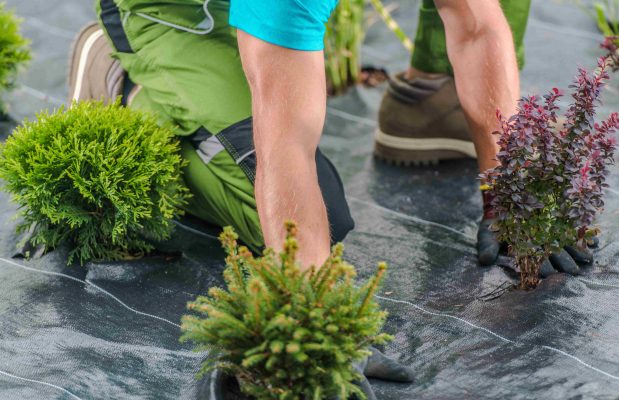
Come to the first inorganic mulch on the list, landscape fabric is an old gardening trick, allowing water, air, and sunlight through the soil while keeping the weeds coming up. Instead of throwing an old rug, let’s use it as a temporary mulch for garden beds.
For aesthetic purposes, this is actually a problem. The material of fabric couldn’t give you an attractive look and especially when exposed under light, the landscape fabrics will degrade. And therefore, to last their longevity, cover it with a second mulch since anyway they’re also ugly!
Click now: Garden Bed Ideas with Trellis
7. Garden Compost
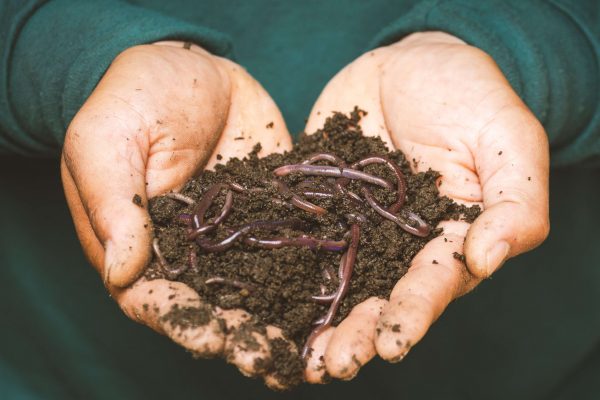
Using compost as mulch for gardens or flower beds is fairly common even when you might not notice. You only need to lay a few inches of some dense compost, it will enrich the soil, and act like an insulator against sunlight, strong wind, and rain accompanied by slowing down the growth of weeds.
This mulch layer is also pleasing to the eyes since it looks like soil that no one can actually notice mulch. Though compost provides maximum benefits for your fruits and vegetables, it’s not a long-term solution for weeds as weed seeds can grow under the compost mulch. Also, compost can decompose so quickly that you need to replenish it often, much more than other types of mulches.
Before applying, you’ll want to check whether your plants are appropriate for the compost materials or not. For example, if your soil has enough nutrients already, adding coffee grounds in compost which contains high nitrogen will make your soil over-nutrient.
8. Cocoa Bean Hulls
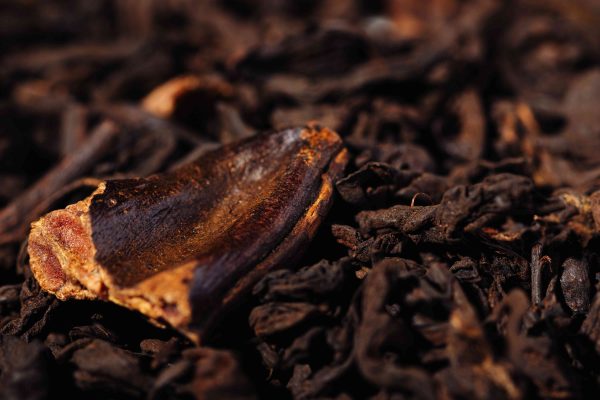
Cocoa mulch acts like a plant food source with the smell of amazing chocolate. Instead of throwing the cocoa hulls during the separating process from the beans, these hulls are kept to create an environmentally friendly mulch for a garden bed. This material is more expensive than other mulches and it decomposes quickly to provide a lot of nutrients thanks to its warming brown colors and chocolate smells.
However, many people are afraid of this mulch because it is not friendly for pets, such as dogs and cats, and other wildlife. Unless you want to poison your dogs, cocoa hulls should be kept away from them. Although this claim has been proved wrong, it’d be better to provide the best safety for your beloved pets.
Also, cocoa hull mulch can retain a large amount of water and attract pests when soggy. That’s why you should only use it in drying zones.
Green Arbor Landscaping – All Services in One
9. Rubber Mulch

Rubber mulch is made from many different materials, but mostly from old recycled tires. Like other inorganic mulches, rubber mulch can last for many years but still keep its own good looks thanks to clean sorts of colors. Once finishing shredded, the result will amaze many people because they hardly notice it once belonged to vehicles. In a way, the rubber doesn’t get dirty and looks cleaner even when being washed by rain.
Although some people prize rubber as a good insulator for soil, it can become the worst ever. Because of being inorganic mulch, it will give back nothing to the soil when decomposing, or even contain toxins or metal contaminants if not properly processed. There is also an extreme issue with rubber mulch of the fire risk – it is flammable and easily catches fire. Moreover, about its aesthetic, not sure whether you want the beauty of plasticky and artificial or not, it depends!
10. Plastic Mulch
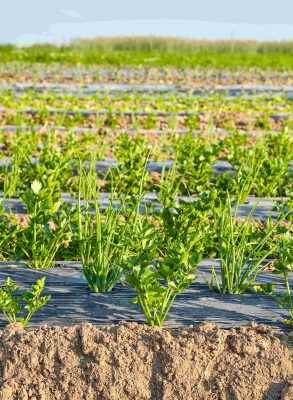
Mulching the garden with black plastic sheets is the ugliest choice among inorganic mulches. However, plastic mulch is highly efficient for controlling weeds even in large fields and insulating the plants well in the winter and spring. Because of the black color of the plastic, it can transmit the sun’s heat into the ground and keep the soil warm and dry, which is useful for growing vines crops such as pumpkins, strawberries, and watermelon.
Let’s create some holes allowing the plants to sprout up since the plastic mulch will prevent water and air to permeate through this layer and the shallow roots which lack oxygen and hydration will decline the plant growth. Moreover, it is an inorganic mulch, and therefore, will contribute no nutrients to the soil.
>>> Explore: Irrigation System for Underneath Plants
V. How to Apply Mulch – West Seattle Landscapers
According to many professional landscapers in most areas around the country, the best time to apply mulch is early spring when the plants still hibernate and weeds haven’t germinated yet. For the best result of getting rid of weeds, apply an ideal layer of 4 – 6 inches with a distance from plant stems of 8 – 10 inches. And whichever mulch you choose, do not leave the soil bare!
To contact a professional in Renton landscaping and the surrounding area, here is the information:
- Phone: (206) 279-1450
- Email: info@greenarborlandscaping.com
- Website: https://www.greenarborlandscaping.com/

